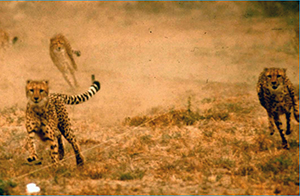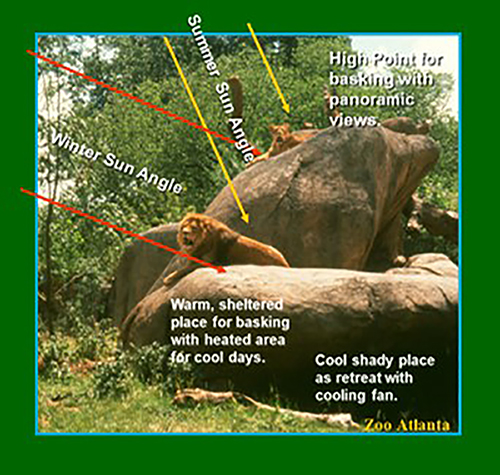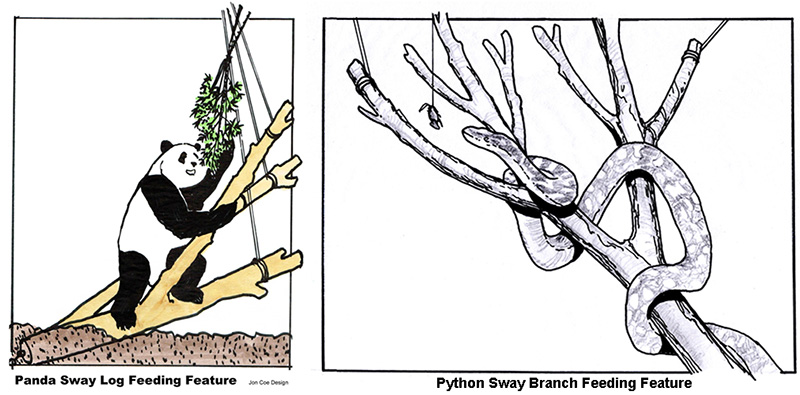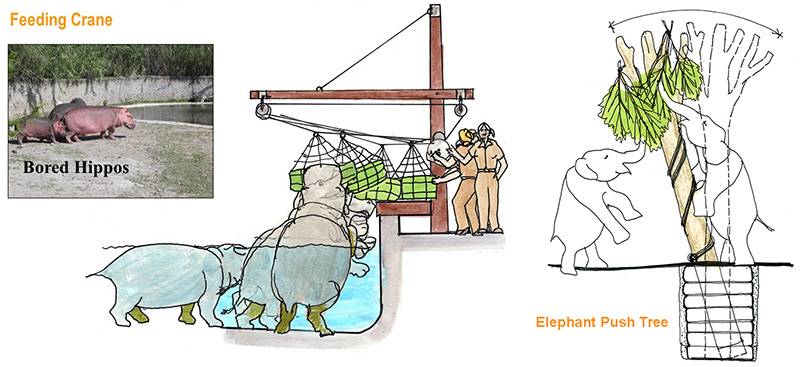Enrichment

in In his excellent 2003 book Environmental Enrichment for Captive Animals Robert J. Young defines environmental enrichment as containing the characteristics paraphrased here:
- “Changes to the environments of captive animals that benefit the inhabitants.” (Young 2004)
- “Changes benefiting animal behaviour can be called “Behavioural Enrichment” (Shepherdson 1994)
- “Changes in the context of the species behavioural biology and natural history.” (Nature is the model)
- “Changes made to structures and practices with the goal of increasing behavioural choice [and control] …increasing species-typical behaviours and abilities [competence] thus enhancing animal welfare.” (V. Hare 1999)
In this section I’ve expanded on these definitions, building on the terms I’ve inserted above and giving examples. Common use of the term “changes” above demonstrates the remedial emphasis on environmental enrichment continuing to this day. As a designer I will expand the definition to include enrichment features “built-in” during the design stage and supplemented by later changing features and programs, all designed to support the animal’s physical, behavioural, and social competence and thus its wellbeing.
This presentation follows the comments earlier in the Ethics and Welfare section because environmental enrichment is an especially valuable tool in improving animal welfare. However, enrichment and welfare also flow from positive changes in animal management routines, caregiver/animal interactions including reward-based training, and improvements in visitor/animal interactions and computer/animal interactions. Arguably profitable business management, funding enrichment programs, is also an essential aspect of environmental enrichment, so it is a dynamic enterprise touching many bases and must be considered holistically.

Built-in environmental enrichment, such as these solar oriented artificial rock formations with embedded heating coils Jon designed over thirty years ago for Zoo Atlanta, gave animals choice & control over ambient micro-climate, provide basking, outlook and hiding opportunities and elevate them to dramatic, dominant positions relative to human visitors. Thus, this ethically designed enrichment feature benefits both animals and visitors.
Types of Enrichment
- Passive Enrichment (built-in semi-permanent physical features such as trees, hills, pools, climbing structures, ropes, and such)
- Active Enrichment (staff-activated elements such as feeding puzzles, novel objects, or rearrangement of semi-fixed objects such as sand piles or logs, fans, or heaters, environmental or other sounds and such. Also changes and variety in food type, location and feeding schedules. (Animal rotation is also a form of staff directed enrichment described later)
- Animal-Activated Enrichment (enriching activities and resources animals can acquire or operate themselves (potentially, but not common yet), such as feeders, fans, heaters, water jets or currents, environmental sounds, and such. Includes on-display and off-display animal areas. Animal/computer interaction, described later, can facilitate animal-activated enrichment.

Elephants at Columbus Zoo must spend many long winter days and all long nights indoors. Since they sleep little and eat often, Jon thought they would enjoy being able to take a shower whenever the wanted. The first night the elephants turned this on 45 times! Later, surveillance video showed they used the shower to moisten their dry hay before eating. When animals are given “choice and control”, they can use it in unanticipated ways to suit themselves.
Enrichment and physical and mental exercise
As Robert Yerkes pointed out in 1925, animals in managed settings need an occupation. That is, like their wild counterparts, they benefit from exerting their bodies and intellects to gaining food and other needs, thus improving physical, mental, and where appropriate social competence. One way to encourage this is to provide access ways to food that are not rigidly fixed and thus require use of spatial perception, balance, and fine muscle dexterity, simulating wild conditions.

Giant Pandas usually sit while eating their low energy bamboo diet, but also need exercise. They are excellent climbers, so using an unstable “sway branch” to access some of their favoured food would encourage physical conditioning. Reptiles are usually kept in very restricted areas, yet they too need good physical conditioning and mental stimulation. Perhaps “sway branch” food access would also benefit many species.

Heavy animals such as hippos and elephant need strenuous exercise, including raising their massive heads. Here are two ways this could be encouraged. The elephant “push tree” is Jon’s variation on a concept first defeloped by Graeme Law for bears and elephants. Provisioning favoured food would be an important motovator.
Naturalistic versus utilitarian enrichment features
Unfortunately, there exists a long and unnecessary dispute, something like this:
Zoo Director: “You can’t use that big blue Boomer Ball or old cardboard boxes for enrichment in our highly naturalistic gorilla exhibit. The ball doesn’t look natural, and the torn-up box looks trashy!”
Animal Caregiver: “My director won’t let me provide environment enrichment to my gorillas!”
Resolution: Use naturalistic forms of enrichment in naturalistic display areas. This may take more imagination and understanding of the educational message embodied in the design of the exhibit (see Naturalistic Enrichment paper link). Use functional types of enrichment such as boomer balls and other “pet store” enrichment types in functional display areas and in off-display areas
Stakeholder Charter: What are the rights of all stakeholders?
Having addressed our obligations to animals in our care, what are our obligations to other stakeholders? What are your rights if you are a caregiver or other staff employee? What are your rights if you are a free-ranging bird living in the zoo or sanctuary? What are your rights if you are a tree in the zoo? What are your rights as the zoo business? Jon conducted a workshop with Melbourne Zoo on this subject. Rights were listed for each category and cross-referenced to identify rights common to all stakeholders: Zoo Animals, Workers and Volunteers, Visitors, Free Ranging Wildlife, Plants, and Zoo Business.
- Respect
- Safety
- Access to critical resources
- Choice, control, and variety
- Optimum welfare for individuals and species
- Thriving – life worth living
Physical, Social and Behvaioural Competence
Zoos have a long and successful history in managing animal genetics to avoid inbreeding. But what good is a zoo or sanctuary animal with excellent genes, but lacking in physical fitness, mental acuity, and social skills?
- Genetic Management is the gateway for maintaining long-term genetic competence
- Environmental Enrichment is the gateway for maintaining long-term individual behavioral competence
- Genetic and Behavioural competence are co-equal requirements
Papers for Enrichment reading
“Coe, Jon C. & Maple, Terry L., 1984. “Approaching Eden: A Behavioral Basis for Great Ape Exhibits” (PDF file 1.84mb) in AAZPA 1984 Annual Conference Proceedings, American Association of Zoological Parks and Aquariums, Wheeling, WV, pp. 117-128. Abstract
Coe, Jon C., 1992. “Plan Ahead for Behavioral Enrichment” in Environmental Enrichment Kaleidoscope: Research, Management and Design, 1992 AAZPA National Convention, Toronto, American Association of Zoological Parks and Aquariums, Bethesda, MD, pp. 120-123. Abstract
Coe, Jon C., 1992. “Animal Training and Facility Design – A Collaborative Approach”, Perspectives on Training in the Zoo — Great Challenges, Profound Benefits, 1992 AAZPA National Convention Proceedings, Toronto, American Association of Zoological Parks and Aquariums, Bethesda, MD, pp. 411-414. Abstract
Coe, Jon C., 1993. “Environmental Enrichment and Facility Design – Making It Work” for First Conference on Environmental Enrichment, Portland, OR (Lecture). (Published 2006 http://www.joncoedesign.com.) Abstract
Coe, Jon C., 1995. “Giving Laboratory Animals Choices” in Lab Animal Magazine, Vol. 24, No. 7:41-42.
Coe, Jon C., 1998. “Chimpanzee Choices”, Keynote Address, Chimpanzoo Conference Proceedings, Jane Goodall Institute, Vol. 1, pp. 17-18. Abstract
Coe, Jon C., 1999. “Increasing Affiliative Behavior between Zoo Animals and Zoo Visitors” in 1999 AZA Convention Proceedings, American Zoo and Aquarium Association, Silver Spring, MD, pp. 216-220. Abstract
Coe, Jon C., 2001. “Activity-Based Design and Management: New Opportunities for Apes and People” in The Apes: Challenges for the 21st Century, C. Sodaro, Ed., Chicago Zoological Society, Brookfield, Illinois.
Coe, Jon, 2006. “Naturalistic Enrichment” 2006 ARAZPA Conference Proceedings, Australia, on CD and at www.ARAZPA.org. Abstract
Coe, Jon, 2009. “Collaborative Enrichment” 9th International Conference on Environmental Enrichment. Abstract
Coe, Jon, 2011. “Architects and Enrichment” 10th International Conference on Environmental Enrichment. Abstract
Coe, J., Rowe, R., Sherwen, S. 2017. “Animal welfare driving the zoo design process: Tools and examples from Zoo’s Victoria. Wroclaw Zoo Design Conference, en press.
Coe, Jon 2017, Embedding Environmental Enrichment into Zoo Animal Facility Design, Wroclaw Zoo Design Conference
Coe, Jon 2017, Proactive Welfare Design Strategies ̶ Animal Focused Enclosure Design, Zoos Victoria Training Need PDF
